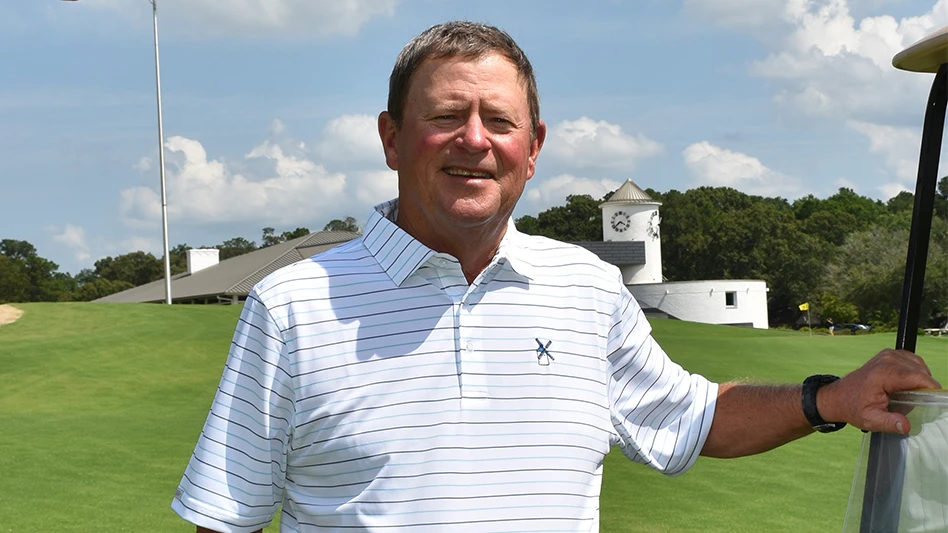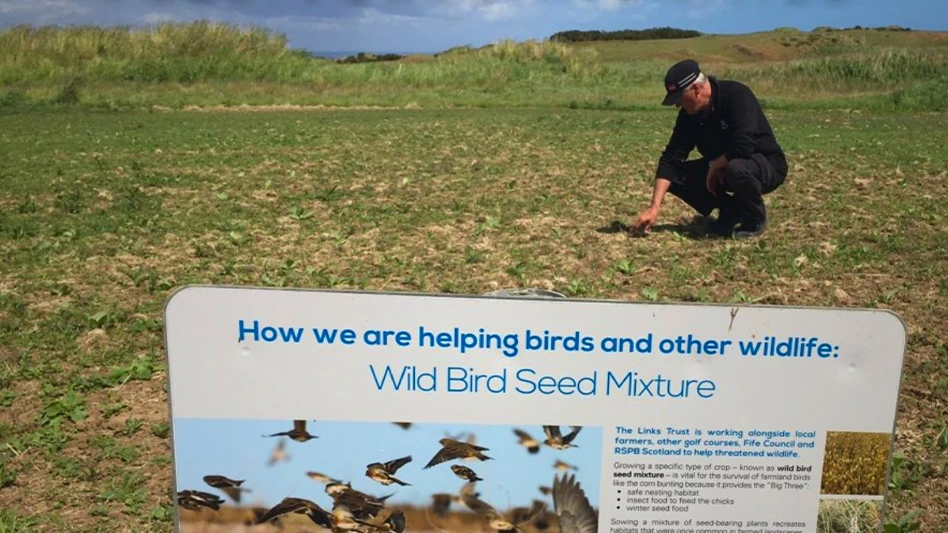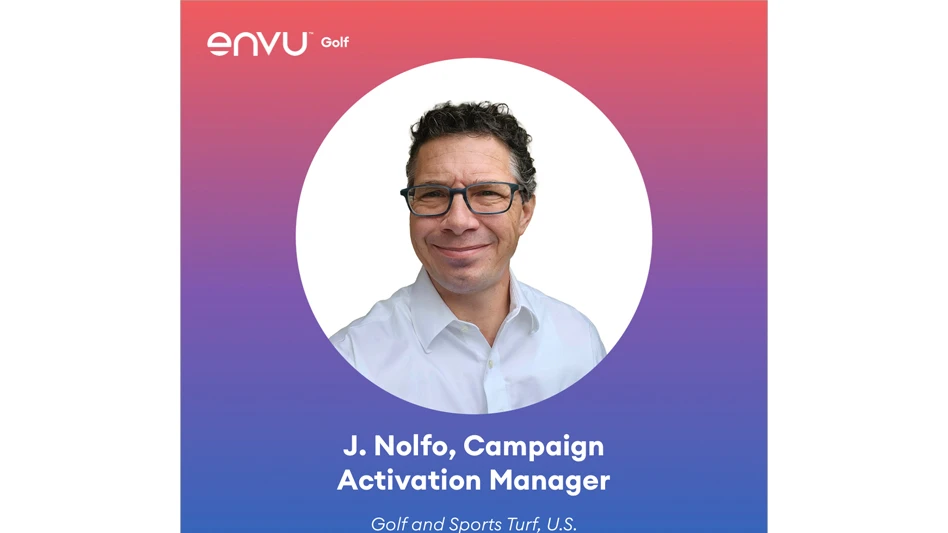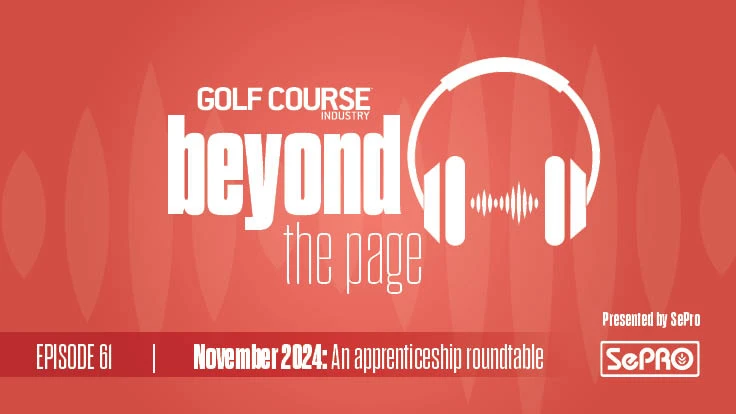 I first met David Pursell when his then fledgling fertilizer company came out of nowhere to become a major supporter of GCSAA in the early 1990s. At the time, I was running the scholarship and research foundation (now EIFG) and I was pleasantly surprised to have a company show up and start giving so generously. It was…different.
I first met David Pursell when his then fledgling fertilizer company came out of nowhere to become a major supporter of GCSAA in the early 1990s. At the time, I was running the scholarship and research foundation (now EIFG) and I was pleasantly surprised to have a company show up and start giving so generously. It was…different.
I had no idea how different Pursell’s path would be.
What I didn’t know at the time I met him was that he had a plan. Plan A for David Pursell was to use branding like no other company had ever used it by building the world’s first and only research and demonstration golf course on a gorgeous piece of family land south of Birmingham, Ala., and – with the help of major partners – use it to sell his Polyon brand to superintendents in small groups over many years. Hospitality, relationships and “getting close to the customer” had always been a part of the golf business, but FarmLinks took it to a new and unprecedented level.
Two decades later, Pursell is working on Plan B. With his company sold, he’s gone from being a savvy fertilizer marketer to being the savvy owner/operator of what is still one of the world’s most unusual golf courses.
I was curious about how my old friend was doing and, when I called him, he simply said what he’d told me and so many folks so many times before: “Come on down and see us.” So I did…and here’s our conversation.
Take us back to the origins of building the company and, ultimately, FarmLinks. The company had a long history even prior to my dad (Jimmy) taking it over in the ‘50s. But we really learned the value of hospitality and relationship marketing back in the mid-‘80s when we got into the sulfur-coated urea business. We built what was one of only four SCU plants in the world and we needed to get outside contract production going to keep the plant busy. The Howard Johnsons (fertilizer) sales folks contacted us and wanted to visit. So, we spent a week creating an agenda and thinking of things to impress them. We swept the floors and got the cobwebs down and really put on the dog for them.
That next week, six guys from Howard Johnsons flew into little “Sylacauga International” airport. We rented a van to pick them up and put them in the old guest house. We arranged evening fun, a plant tour and a fancy slide presentation. The first half of the visit was relational and the second half was informational. We had dinner for them at my Mom and Dad’s house that night and breakfast the next morning. A week later, they called and said, “Thanks…we’ll be switching our SCU business to you.” That’s when the light bulb went off the first time. We discovered the power of relationship marketing: If you can get someone in an undistracted environment for a while and give them the right information, you can sway them. That was the “a-ha” moment when our company changed and, really, that FarmLinks was born.
Wait! Before you start giving birth to the golf course, tell us about how you created the market for Polyon to begin with. We purchased the technology for Polyon and really began to bring it to the golf market starting with the 1992 GCSAA show in New Orleans. Our value proposition for Polyon was that, yes, it was about twice as expensive as SCU but it lasted four times longer. We had to compete against Scotts, Andersons and a bunch of regional formulator/brands. But the leg up we had on others was that the technology absolutely worked. You can do a lot with promotion and PR but the product has to stand up in the market. That was the key thing.
The problem was that we were three steps removed from the end user but wanted to go national with the brand. The question was how you most effectively get that story out there. We weren’t sure whether to do the classic ‘go to the GCSAA show and spend a bunch of money’ route or hire a national sales team like Scotts. Our problem was we didn’t have that sales force or the national brand and we didn’t have regional formulation abilities. We were pretty well known around the Southeast, but nowhere else.
The whole concept was, if we were going to make a big splash, we couldn’t go the same route as everyone else. It was a huge roll of the dice. We weren’t well capitalized and we did a lot of it on debt. But, if we’d expanded manufacturing and distribution and hired a national sales force, it would have been a $300-500 million thing. So we went and partnered with Simplot and Harrells in the early ‘90s and they used Polyon to fuel their growth. They were true joint ventures with a lot of collaboration. They didn’t have to invest in the technology and we didn’t have to invest in formulation, distribution or a big sales force. That gave us the national footprint we needed and we started the national branding.
Well before FarmLinks, you were famous for audacious go-big-or-go-home marketing. Remind us of some of the things you guys did back in the day. We decided to go big with the brand and we even used to use the “Connoisseur of Manure” tagline, which got a lot of people’s attention. Once we had the business set up, we started with national advertising and then that first GCSAA show in New Orleans. Scotts had introduced PolyS and we wanted to make a big splash and to stand apart from them. We wanted people to remember our name, the green color of the product and the spherical shape of Polyon, so we came up with the idea of giving out the basketballs. They were expensive – about $3 each – and we gave away about 5,000 of them. But it worked. People carried them around and others saw them. They’d bounce them in the competitors’ booths! They bounced them everywhere. I remember Tim Orton and I went to Café Dumond in the French Quarter and superintendents and their kids were bouncing them there! We kept on with that for 15 years. We probably gave out 75,000 of those little green basketballs in the 15 years after that.
You also became the most famous artist in the industry for a decade or so. Yup, the Pursell golf prints at the national show were a surprise hit. It started because we used to go to the show with a simple 10’ x 20’ booth and banner and we needed something interesting in the booth. I’d always been an artist (Pursell’s Auburn degree is in graphic design) and I loved doing drawing of golfers. Just for fun, we put the prints on easels in the booth and people liked them. The marketing people from GCSAA noticed and came up with the idea of giving them out to attendees who completed the 18-hole Challenge at the show. It became one more part of our brand and one more thing that bonded superintendents to the company. It was fun!
 Pursell: "So, we threw a Molotov cocktail into the market and decided to literally bet the farm on the power of relationship marketing by building a demonstration golf course to show off our product and entertain and educate customers." Pursell: "So, we threw a Molotov cocktail into the market and decided to literally bet the farm on the power of relationship marketing by building a demonstration golf course to show off our product and entertain and educate customers." |
Okay, now about the golf course… I lived in a little house across the street from the old farm and I used to four-wheel a lot on the property, I loved golf and I had a graphic design background so I would literally fantasize about golf design and building a course on the property, but I was never serious. It wasn’t my goal in life and it certainly didn’t make sense to do it down here in the middle of nowhere for conventional reasons. Then we started growing the company in the early ‘90s and I’d begun to see the power of bringing people down here. We did an early form of the tour with a few customers and a sales rep or two. We had a plant tour and some slides and then went fishing or four-wheeling. It was rudimentary relationship marketing.
I kept thinking that we had to be willing to take a risk and do things differently if we were really going to compete and change the market. You can’t leapfrog anyone unless you jump high. We had the audacity to try. So, we threw a Molotov cocktail into the market and decided to literally bet the farm on the power of relationship marketing by building a demonstration golf course to show off our product and entertain and educate customers.
The other thing we realized was that golf was effectively a market of just 11,000 or so real customers and you could choose the ones who mattered and focus on them.
I met Mike Hurdzan at the (GCSAA) environmental leadership event. I introduced myself and told him I had an idea for a golf course. I got his book and started thinking about it. I knew we needed a way to get our (Polyon) story across and the idea of a golf course started to sound less crazy.
It sounded crazy to your family and other folks in your company, as I recall. Basically I had to win people over one by one. I had to sell the family, our advisors, our employees…but I was in charge and I knew we needed to do it. There were a lot of sleepless nights. We almost bagged it in 2001. We were under construction and everyone hated what they were doing to the land with the D-7s and such. And then Sept. 11 hit. Here we were building a travel-dependent golf resort and people though no one would travel for years and that the economy might crash, too. I called a meeting of the key players in the company and talked it through. Do we postpone, suspend, cancel...what should we do? We decided we’re not gonna let these guys (terrorists) dictate our lives and we recommitted to the course.
 It was a process over time. Building it, doing PR and promotion, creating a good story, etc. Obviously the endorsement and relationship with Toro, Ingersoll Rand (Club Car) and Syngenta at the time lent credibility. We had the idea and the balls to do it and they jumped on board. It’s kind of the drafting effect in NASCAR for them. We put the idea together but our only dog in the hunt was fertilizer. Fertility was well-represented but everyone got their due.
It was a process over time. Building it, doing PR and promotion, creating a good story, etc. Obviously the endorsement and relationship with Toro, Ingersoll Rand (Club Car) and Syngenta at the time lent credibility. We had the idea and the balls to do it and they jumped on board. It’s kind of the drafting effect in NASCAR for them. We put the idea together but our only dog in the hunt was fertilizer. Fertility was well-represented but everyone got their due.
It was clearly successful as a demonstration course, but you never did much to reach out to regular golfers at the time. Public play was secondary. It served to legitimize the course as an active public facility. We got what we got and it didn’t interrupt the Experience to do that. The fact that we spent 10 times on the lodge than what we spent on our clubhouse is a good example of our priorities at that time. We knew that those 15 customers in the Parker Lodge represented more margin than 1,500 rounds of golf. We built the golf course as a marketing tool first and foremost. We never intended to make money on the course.
When we opened 10 years ago, FarmLinks was here solely to do one thing: help sell fertilizer and help our partners achieve their goals with superintendents and other customers.
Then things changed, huh? In 2005, we had three different companies inquire about buying our company. We were pretty heavily leveraged (with debt) because of the plants and the course. I wanted to make sure that at the end of the game of musical chairs, my family still had a place to sit. It was a perfect storm as far as a time to sell. The company had lots of profit potential, great products, great marketing and the economy was still going well. Plus we had multiple suitors. So the time was right and we sold the company to Agrium in 2006. I worked the transition for a year and a half, which helped the continuum, but I knew I was going to have to have a different plan for FarmLinks moving forward the moment we agreed to sell.
We knew that FarmLinks was going to have to stand on its own two legs. Since then, the economy crashed and golf got hit hard. Golf as an industry will always ebb and flow with the housing market and until that comes back, it’s going to struggle.
The correction is going to take place eventually – I think you (GCI) are dead on that we need to have a few thousand courses go away. Golf’s in some trouble right now and it’s going to take some effort and luck to get healthy again.
So where do things stand today? FarmLinks is an LLC (limited liability corporation) owned by four Purcell family members.
Any plans to sell homes or develop? We had a master plan in 2007 to do a build-out but didn’t do it…and boy are we glad.
And how about the partners? Obviously, Toro, Agrium, Club Car and BASF have been fantastic and we’ve had great participation from many others. After the sale, we added the Solutions Center concept and we’ve continued to grow the demonstration capabilities out over time. We added seven cottages and cabins – which was an idea I plagiarized out of trip to Pine Valley – and now have 28 more rooms besides the Lodge. That’s also beneficial to our public golf operation from a stay-and-play standpoint for meetings and events. Even so, we still need more rooms to be able to handle some bigger groups that have approached us.
So how is the public operation doing? We’ll turn 17,000 rounds this year and the Experience is only about 1,000 of that. Daily play rounds have grown every year since 2003. We charge $135 per round and we only do a little discounting. One thing is changing: we never served alcohol and that’s obviously an issue for some groups, so we just applied for our liquor license. We also have new staff people to help us drive conferences, groups, outings, etc. But, it’s just like everything else we’ve ever done: We talk to our customers and position ourselves where they want to be.
You seem to be all over social media and marketing as ways to bring play in. What’s working best? Operating a golf course in today’s economy is one of the most challenging things I’ve ever done. We have a great product and we work hard at it, but it’s tough. If something’s not working, you gotta do things differently. What is that we need to do to get people here. Once they come, they’re sold. That’s why we won the NGF customer loyalty award a couple of years in a row now. People love the way they’re treated at FarmLinks, whether they’re superintendents visiting on business or a group of friends coming in for a getaway.
So how would you sum up the history and moving from Plan A to Plan B? We’re still the only research and demonstration golf course anywhere. And now we are also a world-class hospitality golf course. Whether you’re on business or here for fun, you’re in an undistracted environment with high-quality golf and great amenities. We can’t assume the Experience won’t change in the future. We’ve had more than 10,000 visits by superintendents and others over the years. We have nearly reached my original goal of reaching everyone in what is about an 11-12,000 customer market. No one has ever touched that many customers directly. And it’s all been fully paid. They’ve been entertained and educated…and it’s like a little vacation to them. And most of them, over the course of time, have at least tried Polyon and some of the other products they’ve seen here. Not everyone has converted, but they’ve tried it. It worked. It absolutely worked.
So what’s next for you? We want to get laser-focused on the hospitality piece. We’ve always been good at it for our business guests, now we want to do the same for maybe 100 guests a day here coming in groups. It takes time to do something special…but that’s the beauty of the family core of all of this. We live here. We’re not going anyplace. This is home.
Pat Jones is GCI publisher and editorial director.
Edward Badham Photography

Explore the June 2012 Issue
Check out more from this issue and find your next story to read.
Latest from Golf Course Industry
- Making the grade — at or near grade
- PBI-Gordon receives local business honor
- Florida's Windsor takes environmental step
- GCSAA names Grassroots Ambassador Leadership Award winners
- Turf & Soil Diagnostics promotes Duane Otto to president
- Reel Turf Techs: Ben Herberger
- Brian Costello elected ASGCA president
- The Aquatrols Company story





